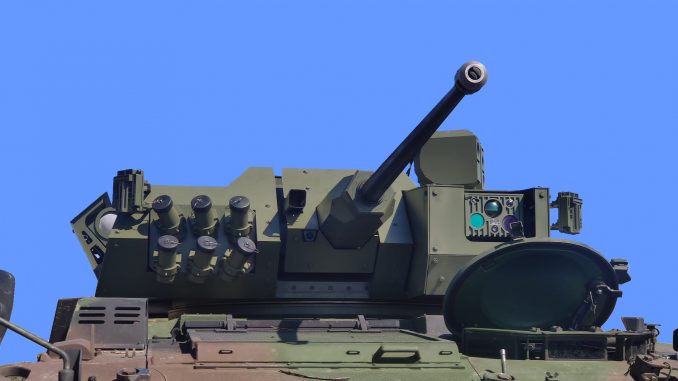
After many ideas and comings and goings, the VCR 8×8 program seems to be moving forward with the assignment of the contract to the TESS Defense consortium, of which it is a part Mechanical & Engineering Notary (EM&E). The Madrid company will be in charge of the design and manufacture of the weapons systems, starting with the tower guardians 30, to which we dedicate this article. A novel design, the result of the ability of EM&E's young engineers to take advantage of the design and simulation tools and the advanced machinery that they have at their disposal at their headquarters in Alcalá de Henares and that allows them to renounce techniques such as casting or welding, betting everything on high precision machining. A different solution whose characteristics we analyze in depth in the following lines.
A few days ago we had the opportunity to visit both the Escribano Mechanical & Engineering factory in Alcalá de Henares, and the old military facilities in San Juan de El Viso that the Ministry of Defense has transferred to the Madrid company and that will be used, among others. many things, to test their new designs of towers, mounts and optronic systems. In addition, we were able to attend various tests of the tower guardians 30, in contention to equip the Army's future VCR 8×8 “Dragón” in its VCI variant. A completely Spanish design and very different from everything we are used to seeing, both for its manufacturing process and for the adaptation possibilities it provides.
The Escribano facilities, located next to the University of Alcalá, initially draw attention for their design, more similar to what we usually see in companies related to the Internet than in the metallurgical sector. However, the most notable thing has nothing to do with the architecture, but is inside its main pavilion: the million-dollar investment made in machine tools, with increasingly complex and larger models. Not in vain, in the last six years they have allocated more than 70 million euros to the purchase of new machines, something that has been possible thanks to the exponential growth of the company, especially outside our country, since it is abroad where they have The more than 4.000 small caliber remote stations and 30 mm naval stations that they have exported - and whose maintenance they are in charge of - have gone to waste so far.
The latest acquisition, which has involved an investment of around four million euros, will allow the frame of the towers to be manufactured, among other things. guardians 30 and the models that are developed in the future on this basis, such as the tower for the VCR VEC (Cavalry Exploration Vehicle). A monster capable of machining steel blocks of up to four meters, allowing the company's engineers possibilities that are far from those offered by more traditional manufacturing procedures, such as casting or welding.
The result is, to say the least, curious, since it is a structure full of edges, perforations and holes that is far from traditional towers. Thus, to the frame of the guardians 30 The armor plates and the different components that make up the assembly are screwed together, using numerous bolts, from the system that can accommodate two anti-tank missiles to the 30 mm cannon, the secondary weapon, the smoke throwers or optronic systems, among others. A very light and compact set that has two fundamental advantages: 1) complete modularity and adaptability and; 2) all of this is designed and manufactured in Spain and by Spanish engineers, which means, unlike other models, that technological sovereignty is complete.
Regarding the first point, the possibility of modeling the necessary changes using 3D design software and then manufacturing the part using machining machines offers unlimited options. For example, if when adapting the tower to a specific model of armored vehicle, problems are observed with the position of a hatch or with any other interfering element, the engineer can always adapt the design. and following the best practices with a flexibility that is impossible when it comes to cast or welded towers. As a button shows: after giving up our Marine Corps a Piranha IIIC to the company for testing, it was found that the tower ring was of a different diameter than that of the vehicle. It only took a few hours to design and machine a funnel-shaped piece that would allow the guardians 30 to the armored chassis.
Regarding the second point, it is worth elaborating a little more. Normally, when a large contract is negotiated and the Ministry of Defense, through the DGAM, as is the case, launches a Request for Information to the industry or publishes a series of specifications, reference is always made to the country's industrial participation. . This is a problem and leads to misunderstandings, since it normally refers to the percentage of the total contract that is produced by Spanish companies, that is, that “stays” in Spain, but not to industrial property and design authority.
As a consequence of the above, it is normal that in many competitions national and foreign manufacturers join forces to jointly offer systems whose intellectual property always belongs to the foreign company, something that we have seen on numerous occasions and of which there are plenty of examples in the case. of the towers for the 8×8 VCR Dragon. In this way, an Israeli or Belgian company with a local partner has access to a program that, alone, would be prohibited. However, we should not be fooled, because despite the fact that the Spanish company earns juicy income and a significant know-how, the design authority is always in the power of the foreign company.
In other cases, as we saw regarding the Leopard 2E, the manufacturing license for an already tested design is acquired (whether or not introducing changes to the buyer's taste) and the local industry manufactures or assembles components until the agreement in the contract is met, at which time the activity must cease. It is the reason why Spain could not export these battle tanks to Saudi Arabia, since Santa Bárbara had been sold to General Dynamics and it was difficult for the Germans to have agreed to grant new licenses to a company that was a direct competitor. In this case, as in the previous one, local companies learn about manufacturing processes, ways of working, organization and many other things, but ultimately technological sovereignty continues to remain outside the country.
The last option is the most complex and consists of designing and manufacturing locally, which sometimes leads to serious problems, as has happened with the 8×8 VCR. Dragon or with the submarine series. However, this is Escribano's bet, a company that has already demonstrated that it is capable of selling its products abroad, competing on equal terms with renowned companies such as Rafael, Cockerill or Rheinmetall and beating them on numerous occasions. In this case, the company not only designs its own systems, but also manufactures most of the components: from the frame we have talked about to the electronics, the wiring, the lenses of the optronic systems or the printed boards. Of course, its programmers also develop the software necessary to make the set work. Everything is made in Alcalá de Henares, except for what makes no sense to manufacture, such as the cannon (they couldn't do it better than Northrop Grumman, much less at the same price) or some of the electric motors that move both it and the tower and which would be uneconomical. produce. That is to say, it is not a question of 70, 80 or 90 percent of each guardians 30 is made in Spain, but that, as the towers are entirely Spanish designed, they can, if necessary, be exported or manufactured in the quantities that our Armed Forces need, without depending on licenses or good relations with third parties.
Only in this last case is technological sovereignty total and that is something that we must defend to the extent possible. Always understanding, of course, that it is not possible in all cases, nor is it worth it, because for the system to be sustained, the products derived from the programs must have real export possibilities, although that is another matter that We have already tried on several occasions. This also leads us to a controversial question: should a contract be assigned to a Spanish - or European - company simply because it is one? Even when the competition offers better products? In our opinion, and unless the product is significantly inferior to the competition, we understand that yes, the most appropriate thing, as long as the product demonstrates that it meets all the requirements set by the Ministry of Defense, is to trust the national industry. It is the only way to continue strengthening an industrial-military ecosystem that employs thousands of excellently trained engineers and technicians and that contributes significantly to both our GDP and our security. as we explained in its day. Now, this must be done without tricks or cardboard, evaluating each system or component with light and stenographers, since purely military needs are non-negotiable and it is useless to bet on the defense industry to the detriment of defense itself, something that we have done in too many occasions.
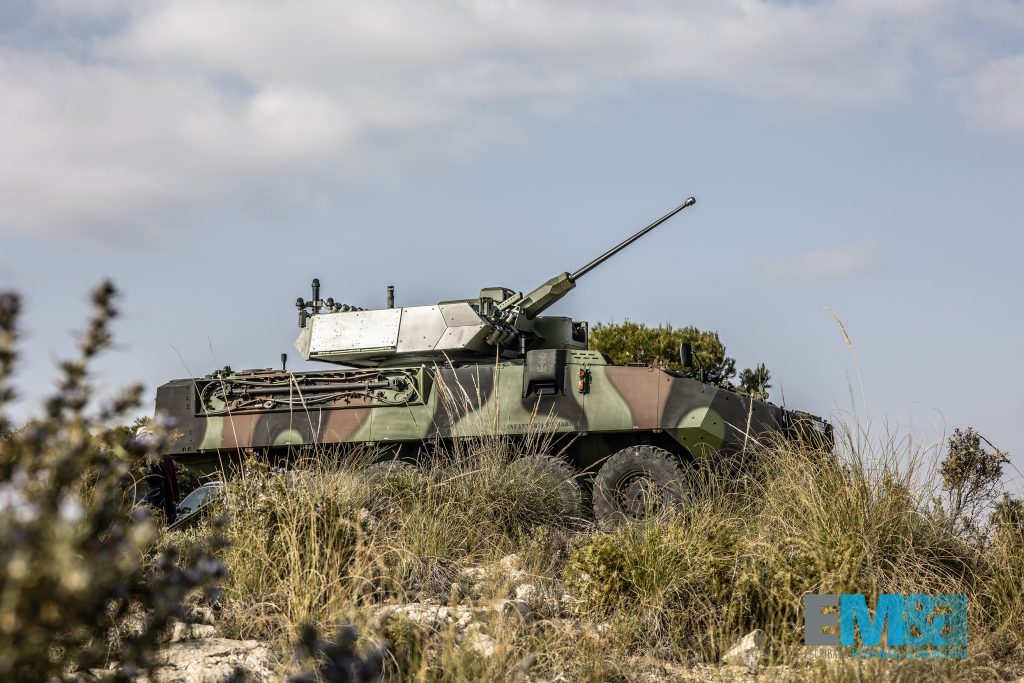
The 8×8 VCR Dragon
El Dragon, the Army's star program, is intended to replace most of the outdated TOA, BMR and VEC armored vehicles in service with a modern 8×8 manufactured entirely in Spain. However, this important program (which aims to manufacture up to a thousand vehicles, with the first phase being 348 units) has not been without its share of surprises. In fact, on more than one occasion we have analyzed in depth the numerous setbacks suffered, so we will not go into it further. Originally assigned (by negotiated procedure without publicity) to a UTE (temporary union of companies) formed by SBS, Indra and SAPA, which were awarded a contract for the development of five technological validation prototypes (of the different subsystems), the production contract was finally declared void by the Ministry of Defense, unable to present a proposal that met any of the established requirements.
Already in this phase, Escribano was present in the project with the guardians 2.0. However, the rest of the preselected models responded to other manufacturers, specifically the Samson (12,7 mm and 30 mm versions) from the Israeli Rafael ADS in collaboration with Pap Tecnos and the UT30 mk2 from Elbit systems, also in 30 mm, in which Navantia and Expal participated, under the (national) name tizona.
Shortly after this milestone, Escribano presented an unmanned tower with the same cannon (required in the specifications) Mk44 Bushmaster II in which Leonardo collaborated, although the idea was discarded by the Spanish company to focus on a project that was entirely national. In addition, its successful machine gun turret guardians 2.0 He did not stop scoring sales successes, especially outside of Spain, where he did manage to win a contract from the Spanish Navy.
These efforts did not go unnoticed and when the Ministry of Defense urged those involved in the VCR 8×8 Dragon to redefine the project, the only acceptable option was to achieve the maximum degree of nationalization, so that no tower designed abroad (even if it bore the seal of being manufactured in Spain) and over which there was no design authority (exactly the same happened with the vehicle itself, based on the Piranha V Swiss, but entirely Spanish) was going to be accepted. So much so, that Escribano became part of the new vehicle manufacturing company, called Tess defence, taking charge of all the towers requested.
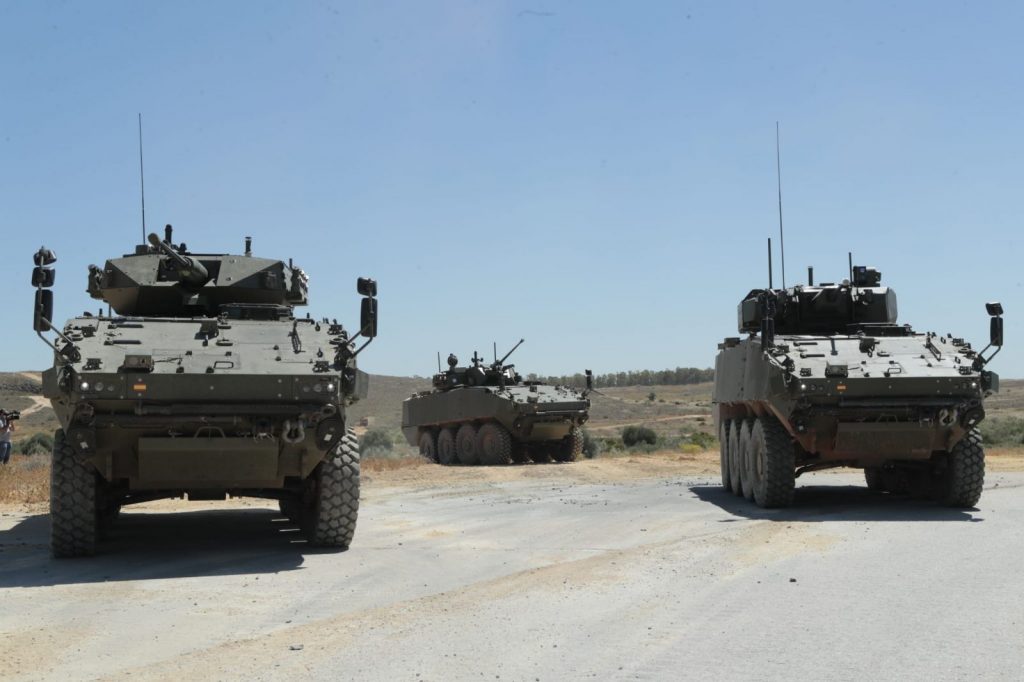
The new tower guardians 30
Known as guardians 30, the recently presented tower derives from Escribano's previous experience in collaboration with other companies, although in this case, making good use of the lessons learned, it has been developed entirely by its engineers. It is intended to equip the main variant of the 8×8 Dragon, the IVC (Infantry Combat Vehicle).
To give the company more time to develop it, the program schedule has prioritized other variants, such as the VCZ (Sapper Combat Vehicle) that equip a simpler mount (in this case the guardians 2.0 of the clerk herself); although given the speed shown in its development (there was no small expectation about it) this could vary, since the VCI Castor (version of ASCOD of sappers) is two years late, so it is doubtful that such a complex variant (at least when it is in the hands of SBS) can be in time to start production.
As the program defined, the guardians 30 It is a robotic tower, controlled from inside the vehicle by two people and armed with a cannon Bushmaster II Mk 44 30x173 mm electrically driven (which means that it does not use the projectile gases to repeat the firing cycle), stabilized on two axes and with dual-track feeding (it supports two different types of ammunition to choose from). a selector) that can be recharged by accessing the tower from inside the vehicle or from the outside from an upper hatch. The ammunition loading capacity is 200 shots and the pods are ejected towards the front of the vehicle once used.
The cannon has a maximum depression angle of -15º with respect to the horizontal (which allows it to fire at targets close to the vehicle) and the elevation is +60º, which is fair if it is intended to be used in urban environments. or against aerial targets of the UAV type or loitering ammunition. However, the rotation speed of the tower, 60º per second, is excellent for an almost immediate confrontation with any threat, something we were able to verify in the factory.
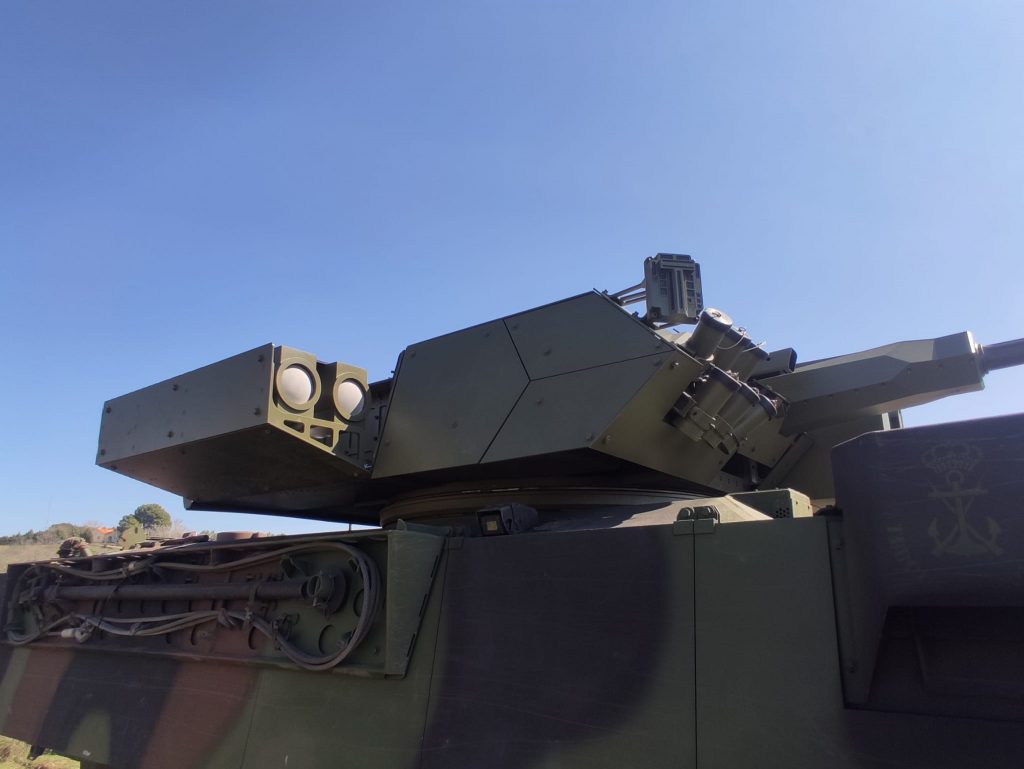
It features a 7,62 coaxial gun (MG3S) with an attached drop-in ammo box and the option of a dual missile launcher. In principle, the Spike, in service with the Army, but the system is compatible with other models such as the Javelins or the modern ones MMP. The arrangement of the latter is quite ingenious since, placed on the right side of the tower, it integrates perfectly into its profile when closed (it is an integral part of the tower and is an armored compartment) opening in the shape of a fan ( 90º) from a hinged axis at the bottom, leaving the launcher aligned with the tower on its side and not in a telescopic upper mount, like other competing models. Once it reaches its maximum opening and facing launch, the platform that carries the two missiles rises at an angle, after which the shot can be fired. The compartment is designed in such a way that in the unlikely event that the missiles explode inside, due to the tower being hit or for any other reason, the force of the explosion would be released to the outside, without affecting the occupants of the vehicle. , the same as with 30 mm ammunition.
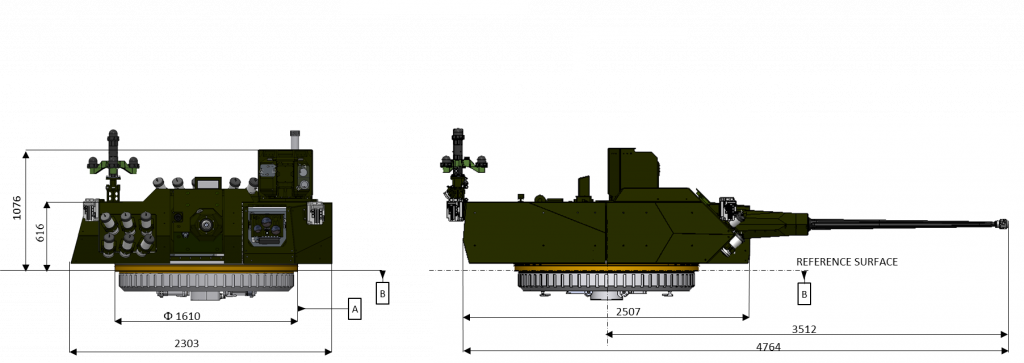
The panoply of weapons is completed by a battery of twelve Weigmann smoke launchers (they can launch fragmentation grenades), located six in the front right and another six in the rear.
The first thing that catches your attention about the tower is its low profile (616 mm), and in the tests it is installed in a Piranha IIIC of the Marine Corps and to attach it a ring has been provided, as we mentioned at the beginning of the article, which raises the tower above the roof of the barge and which will not be used in the final mounting, further lowering the profile and center severity of Dragon. In this regard, the basic tower weighs 1.066 kg and supports modular armor plates (they are attached to the structure without modifications using bolts) of different degrees of protection. These plates can combine different types of materials, metallic and composite, and support the installation of reactive shielding. In the same way, The tower could easily incorporate active protection systems.
The module installed for the tests, the same one that we can see in the images that illustrate this article, offers STANAG 4569 level 2 protection (Supports cartridges from 7,62 to 30 m), which represents an overweight of 480 kg compared to the tower naked. In the case of incorporating level 4 protections (14.5×114mm at 200 m) the weight of the guardians 30 in combat order (with ammunition) it would rise to approximately 2.000 kilos, still far from direct competition (4.300 kilos per UT30 Mk 2, 3.000 in the case of the Cockerill 3030 or 3.300 for the Throw).
Finally, it is worth highlighting the flexibility and growth possibilities. For example, just in front of the missile compartment, on the front right, there is a space to house various electronic components that could be assigned to other functions if some equipment is not mounted, which offers important versatility. At the end of the day, as the chief engineer, Fernando Fernández González, told us, when designing the Guardian 30 emphasis was placed on versatility, not thinking so much about integrating a specific weapon or system, but rather about creating a base that allows adapting very different weapons and systems and always leaving an important capacity for growth in the face of the incorporation of external equipment.
| DIMENSIONS | |
| Tower width with armor | 2.303 mm |
| Tower length without main gun | 2.507 mm |
| tower height | 616 mm |
| Total length of tower with main gun | 4.764 mm |
| Distance from ring axis to end of main gun | 3.512 mm |
| ring diameter | 1.610 mm |
| MASSES | |
| Tower with weapons and ammunition | 1.055 kg |
| Protection level II shielding | 480 kg |
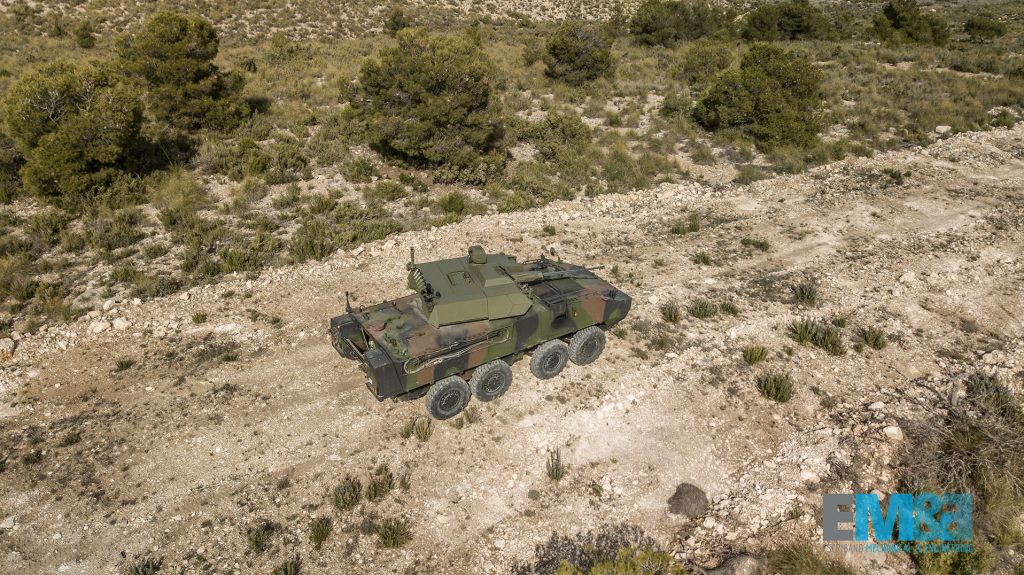
Vision and aiming systems of the Guardian 30
The tower has two sights as vision and aiming elements, one on the front of the tower and in line of fire with the main gun, known as SGS (Stabilized Gunnery Sight) and another panoramic one for the vehicle leader (SPS or Stabilized Panoramic Sight) on the roof, with a 360º field of vision. Both are stabilized in two axes and have a third-generation thermal camera, high-definition daytime TV and laser rangefinder (associated with the ballistic calculator).
Both scopes have tracking capabilities (tracking) of targets independently, with the shooter having a system of automatic orientation of the barrel sight with the scope's reticle to fire immediately on the target. Also unusual is the lateral scanning capability of this scope (azimuth from -10º to +60º) which allows the shooter to observe in a wider field without having to move the turret or use the stabilizer's ability to keep an eye on a moving target. .
In this regard, the precision of the weapon is quite good, exceeding 80% accuracy in the tests carried out to date moving on the track (20 km/h) on targets at 1.000 m, the margin of error stipulated in these conditions is 0,5. .0,030 mRad (angular measurement equivalent to < XNUMX degrees).
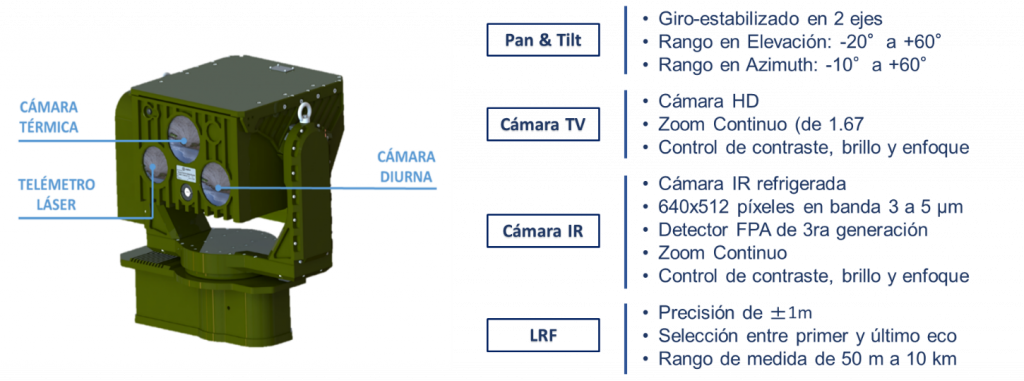
Another quality of the tower is that the positions of the operators are interchangeable, using their consoles and controls interchangeably to operate the tower and the two displays. Only the power to assign priority when designating the target to fire on distinguishes the position of the chief in this regard; although other vehicle systems unrelated to the mounting are another matter. This, in the words of those responsible for Escribano, represents one more step towards the Hunter-killer concept, since by relocating each position, all the functionalities can be executed from any of them. That is, the commander and the shooter can exchange their positions without affecting the mission and, if one of the positions or any of the optronic equipment is damaged, the latter could continue using the rest from either of the two screens. In this regard, the control software is open architecture and is easily integrated into the vehicle's mission system, being able to receive information from it (such as messaging, BMS traces or mapping) on the console.
Also important is the training mode, through which the system presents operators with an external virtual system for vision and fire practices with cartography, inclement weather and different predefined scenarios. Once completed, the software issues an evaluation report that can be exported to a PDF file.
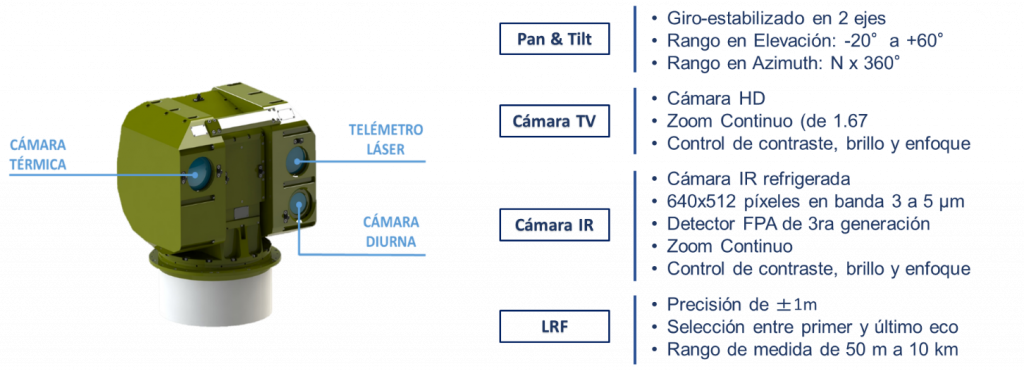
Features of the vehicle boss SPS viewer. Source – EM&E.
Own production
The program office VCR 8×8 trusts Escribano and its ability to design and produce an automated robotic tower that could meet the program requirements Dragon and with the perspective of positioning it within a very competitive market.
The objective has been met, since apart from the success obtained by the company with its range of products, the capacity for its own production of modules and subcomponents (sensors, shielding modules, wiring, printed cards, control software, consoles, etc.) It is guaranteed, as it is carried out in the facilities of the Madrid company. To this end, it has invested significant sums in computerized design machines, so that its towers can be configured digitally in a few hours (according to ergonomic tastes, the need for new weapons or systems or implementation on other barges), immediately going into production using a monobloc machining (the frame is not welded or cast). They also manufacture their own optronic circuits and systems, even having an optics laboratory where they manufacture the lenses and which places orders for many other companies, some of them highly renowned and which sell their systems as their own.
This firmly positions the company for future developments, beyond the returns of producing the more than 600 towers planned within the program. Dragon, and what it does to the guardians 30 so interesting. It is not that the others are bad towers, since for example the tizona Elbit/Navantia/Expal shares many of its characteristics and is also an excellent weapons system, but it does not provide the productive autonomy or growth that the Escribano model offers.
The company's next milestone is related to this same program, since the Army continues to request a manned tower for its cavalry vehicles, whose production should begin in 2026; although the program's current spending ceiling does not contemplate it, perhaps because the tower has not yet been developed. In any case, surely the model that the company presents will have a great commonality of components with the guardians 30, which is an undoubted advantage.

Beyond the Guardian 30
The current trend is to increasingly resort to robotic towers, that is undeniable. However, despite its benefits, the concept also suffers from limitations, which is why it is not suitable for all types of vehicles. The intention to integrate a manned tower in the future VEC (Cavalry Exploration Vehicle) Dragon It has not been without controversy. At the time, SBS, unable to meet the program's milestones, proposed eliminating it to save costs, arguing that an unmanned one (which was not even chosen) was enough.
At that time the preferred one of the Ministry of Defense, which did meet the requirements emanating from the Directorate of Research, Doctrine, Organic and Materials (DIDOM) of the Training and Doctrine Command (MADOC), as well as the Cavalry Headquarters; was the Hitfist, a tower then armed with a 242 mm M25 that had already been tested in 2007 aboard a vehicle that was postulated as FSCT (Future Ground Combat System, predecessor program of the current Dragon), which was none other than the Arrow from the also Italian IVECO.
This tower was going to be installed in one of the five prototypes of the technological program that, after the creation of Tess defense, have been left in limbo, accumulating enormous delays (they should have been made available to BRILEG for evaluation in 2020) and without that there is evidence of firing more than two of the towers: the Samson and tizona (a situation that could change shortly if Escribano receives, as he hopes, one of the demonstrators in the coming weeks). Thus, the program is awaiting the development and testing of a manned tower, with the production of 58 vehicles from the first batch being signed without this weapons system, which remains a paradox even though it allows the program to be launched without more delays.
The need put forward by the Army is not gratuitous, because unlike the BMR (TC-3 remote turret) and the TOA (a simple mount for AMP), the VEC M1 which it must replace has a manned tower, also of Italian origin, model TC-25 (with the excellent Bushmaster M242 25x137mm). The rest of the new generation reconnaissance and combat vehicles continue to rely on this same manned tower concept, in search of the necessary situational awareness of a combat team aimed at obtaining information. This is what happens with the Jaguar 6×6 French and with the Ajax British, a derivative of ASCOD2 from GD-SBS. Of course, both choose to increase the caliber and carry the excellent 40mm CTAS cannon and telescopic ammunition. The MADOC has also spoken about this weapon and the need to reinforce the VEC's weapons; There are already offers from other manufacturers, such as the Belgian Cockerill, to install a factory in Spain that meets the needs of the FAS (The Marine Corps has shown interest in its 105 mm tower). In fact, most tanks, tank destroyers or cannon support weapons, such as the VRCC Centauro or the M1128 MGS (Mobile Gun System, a 105mm derivative of the Stryker) still carry a manned tower (A notable exception is the Armata Russian, which still does not enter mass production).
Another reason why the crew should be able to leave the vehicle is to provide security close to it, either with a machine gun mount or with their regulation weapon (FUSA). In this regard, it is not difficult to find graphic evidence of armored vehicles on urban patrols or checkpoints with the crew members leaning out of the hatches with their 5,56 rifles and personal protective equipment (helmet and anti-fragment vest) despite the risk and the narrowness of the location.
In this case it must be said that the guardians 30, unlike other unmanned towers, has the advantage of having a practicable hatch through which a crew member can exit (the Piranha V It also retains the vehicle's head hatch, located behind the driver) also equipped with an auxiliary vision periscope. It would therefore be an excellent basis for the development of that hypothetical manned tower that would share a good part of the components, in the opinion of the company's staff.
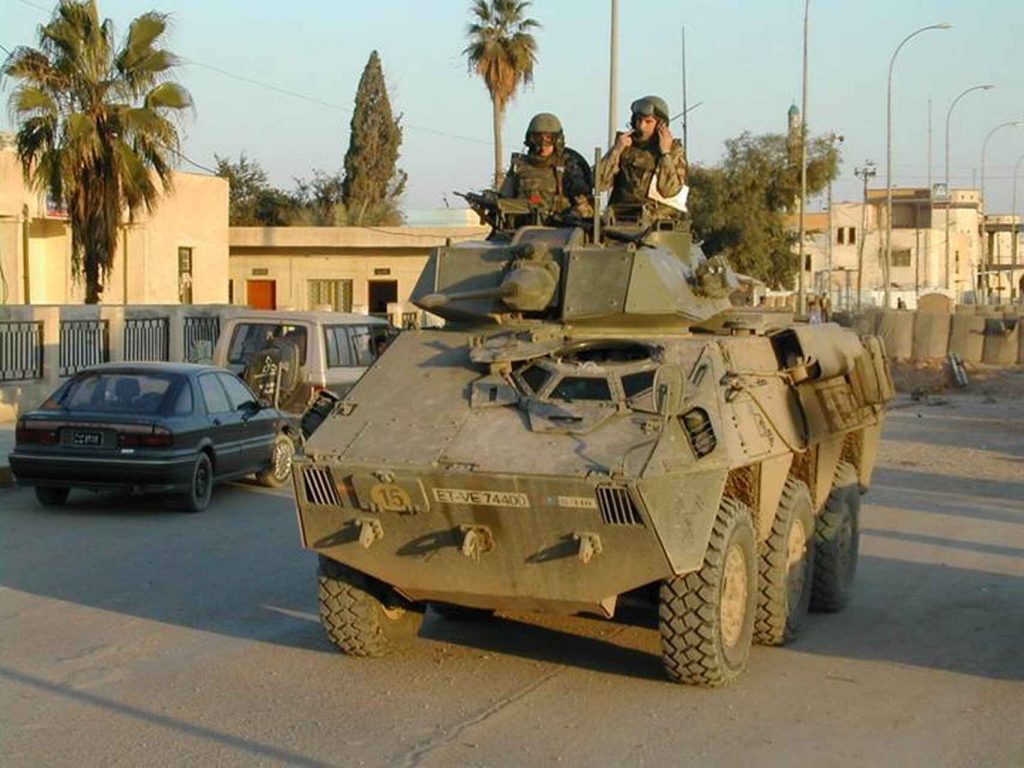
The role of the new El Viso facilities
On the outskirts of Alcalá de Henares, surrounded by the Tejón ravine, the Army had a series of facilities and land, including magazines and shooting galleries, which had been disused for years. After several rounds of negotiations between September 2020 and this month of March, the Army has agreed to transfer the land to Escribano so that the company can not only test its weapons systems but also build - and in some cases, rebuild - a series of buildings intended for multiple tasks, from experimentation to representation.
As far as we know, the company plans to invest up to twenty million euros in the coming years in the creation of what they call an “R&D&I Center of Excellence” which, if carried out, will be unique in Spain and will be It will be among the largest on the European continent. In addition, the new buildings will allow the company to increase its workforce from the 450 employees it currently has to 600 before the end of this year. The objective is to “have our own testing ground for training and validation of the developments made available to our Armed Forces and the creation of the first National Center for the development, scientific calculation and simulation of cutting-edge dual-use technologies.” ”.
Precisely, a few days ago we had the opportunity to visit the facilities, still in a very precarious state. Accompanied by Ángel Escribano Ruiz, CEO of the company, and Fernando Fernández González, chief engineer, we were able to take a short tour of them during which they explained to us some of the projects that the company contemplates. These range from the construction of a test track in the shape of an eight or another with different speed bumps in which to test the observation, stabilization and aiming systems of its towers to a residence (called guest accommodation) in which to host the delegations of other companies and states interested in the company's products. Furthermore, as in the current facilities, which have, among other things, a gym and a dining room, they are considering the possibility of providing El Viso with a swimming pool and space to organize barbecues so that employees can relax, something extremely useful. when you depend on your inspiration or your ability to concentrate more than on physical effort.
If they manage to carry out their project, as it seems (the excavators have already begun their work), in Escribano they will have managed to overcome a new milestone, being able to test their own systems as many times as they deem necessary, also adapting the terrain to their needs, which It will give them a competitive advantage over other companies in the sector.
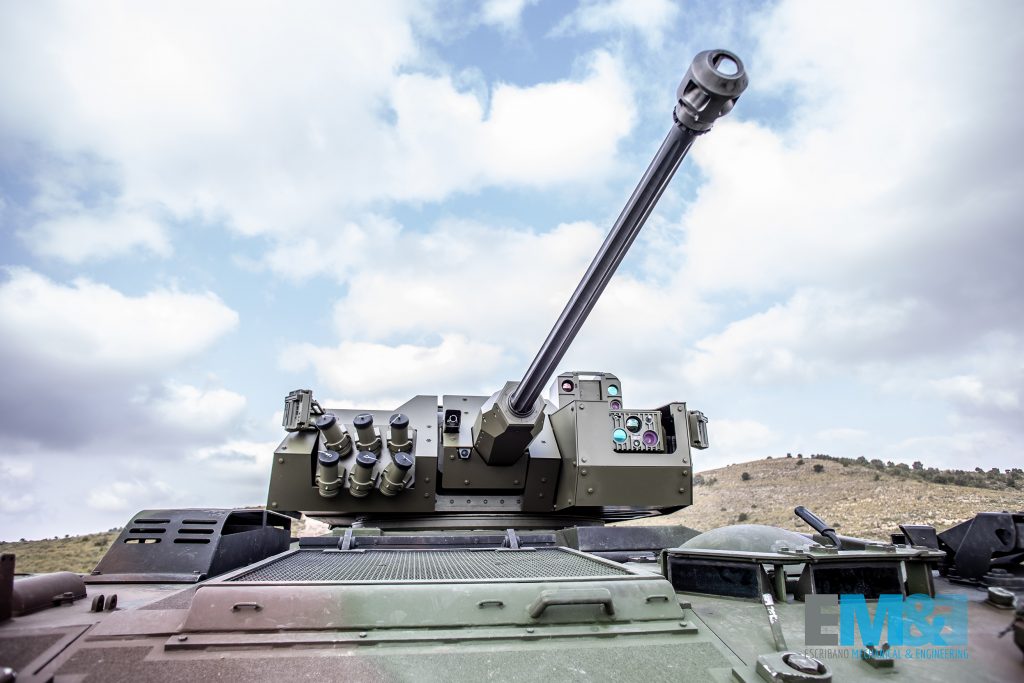
Conclusions
Escribano has assumed the commitment to develop the towers of the program Dragon, having already presented a product that seems to meet all the requirements imposed by the program. Without a doubt, the company's commitment to developing a product based on its own means and capabilities is commendable. The fact of designing and producing the vast majority of these in Spain, using Spanish engineers and having demonstrated their ability to win contracts abroad before doing so in their own country, is quite an endorsement. Let us not forget that this, and nothing else, is what makes the Spanish defense industry stronger and nor that a strong industry is a guarantee of a strong defense. An industry whose capacity is not measured by the size of the facilities, nor by its capacity for political influence, but by the number of Spanish engineers and technicians it employs, preventing them from joining the workforce of competitors in Germany, France or any other country, something that has been happening for a long time.
The company continues, however, with the tests, still having to overcome some quite delicate milestones, such as the integration of the new guardians 30 with the combat system Dragon (in fact, it has not yet been physically implemented in the vehicle as they are waiting to receive a demonstrator) or the missile firing test. The investment they are making in El Viso will be key in this aspect, allowing them to shorten development times even further. Furthermore, looking to the future, the possibilities of these facilities go much further, so it will also be interesting to see how far they are able to implement their projects. Likewise, the company's engineers are working against the clock to offer an alternative, based on the guardians 30 that meets the cavalry weapon requirements for the program Dragon, a challenge that appears exciting. A powerful mythological creature that has already begun to show its teeth.

Be the first to comment